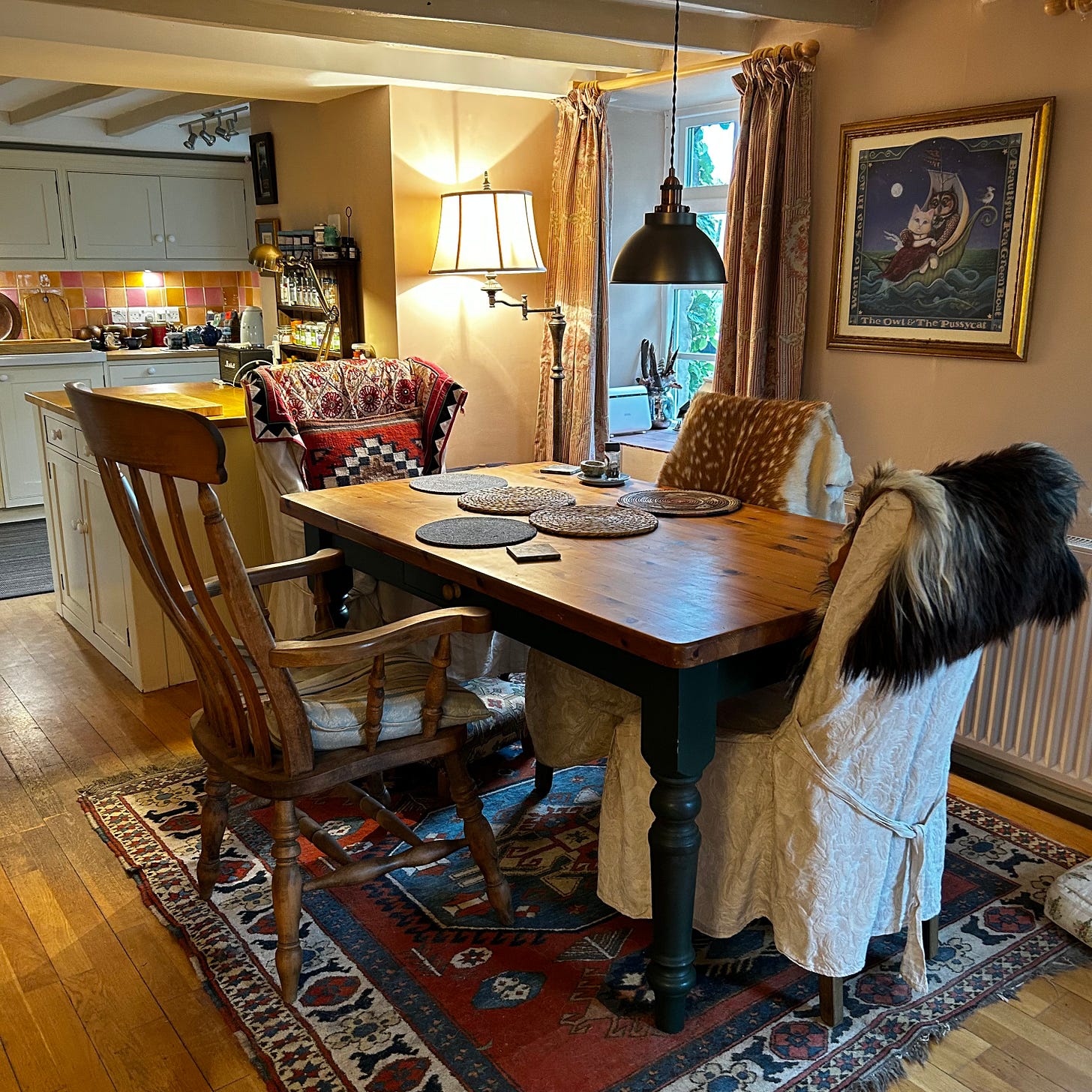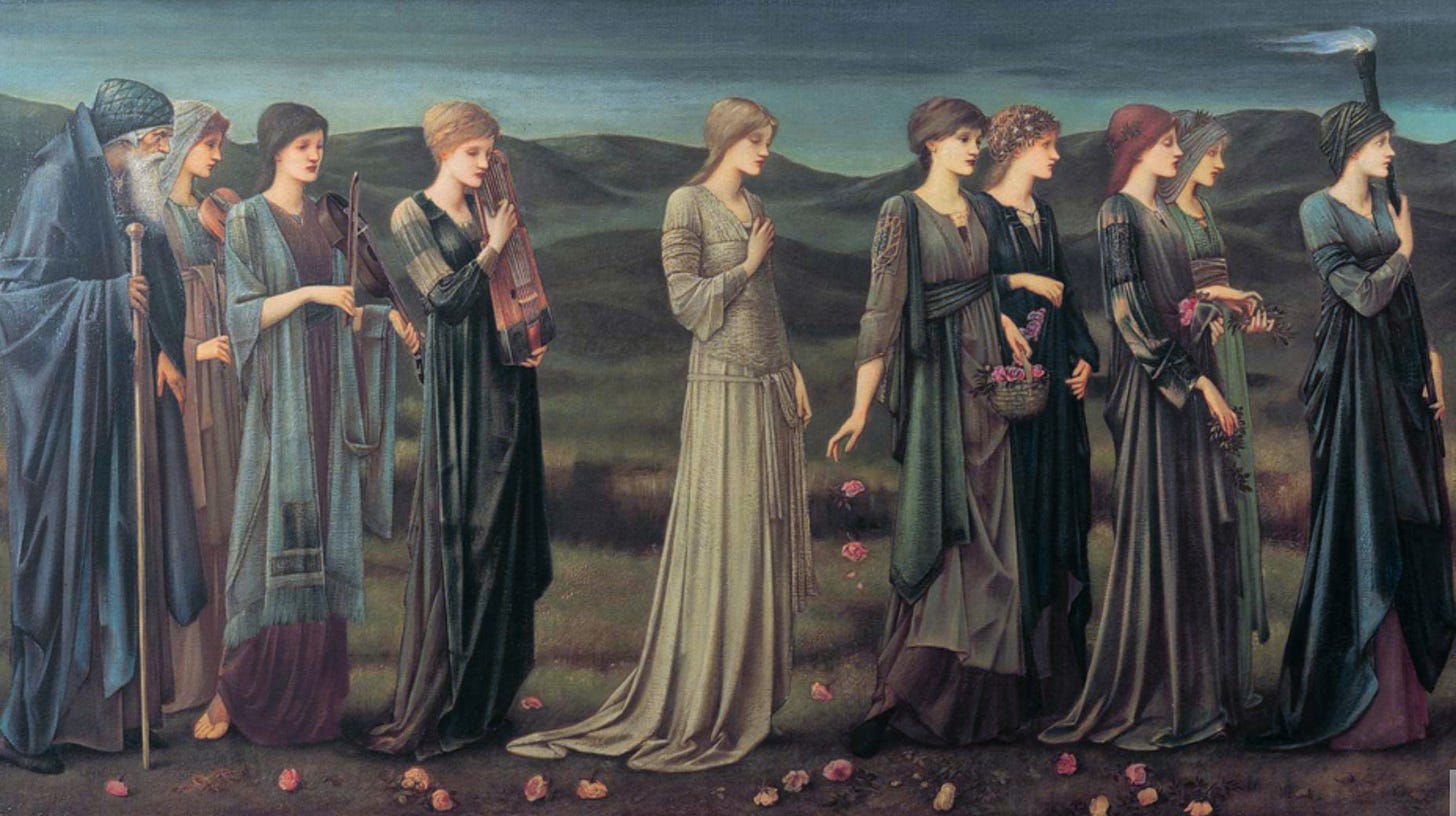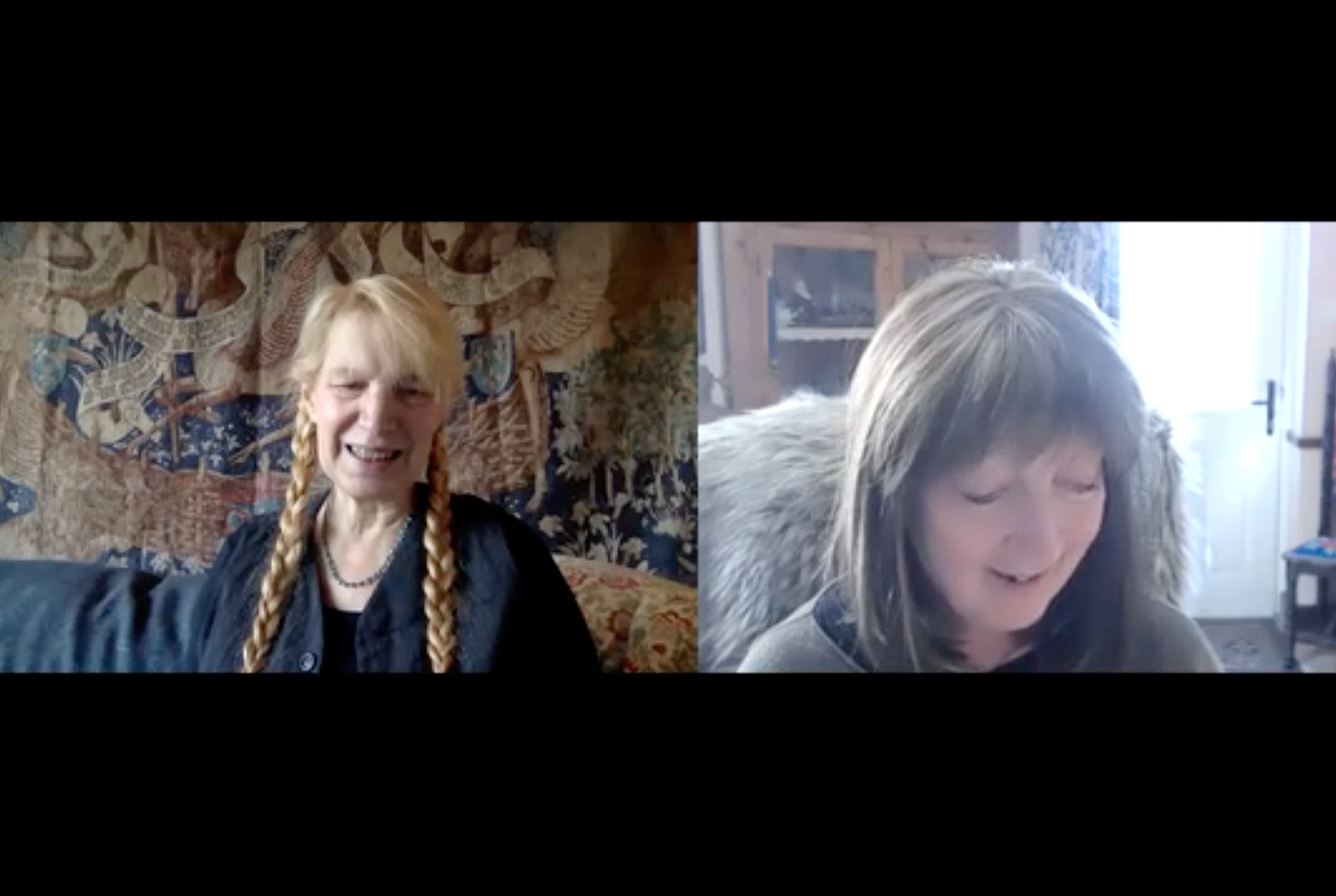Dear friends,
So after writing last month about how summer disconcerts me, it seems as a consequence to have vanished entirely from this island – or at least, from the northern part of it that I inhabit. You may now call me The Old Woman Who Hexed Summer. Truth is, I’ve loved it; it’s made July – my least favourite month of the year, when getting through the heat and the light seems like an impossible slog – bearable. And if summer should think of returning before autumn begins properly to set in, then I’ll be grateful for it for once, rather than grumbling.
At least all the rain has given us the opportunity to carry on working on the inside of the house, and I’m delighted to announce that after the next month is over I hope to have run out of walls and woodwork to wallpaper and paint. I then have around nine pairs of curtains to sew to populate the wooden curtain poles David that has been painstakingly fitting, but at least that will represent a change. We finally have a functioning guest bedroom and a bathroom that isn’t 1970s avocado-green plastic is forthcoming. (Please don’t tell me avocado green is making a comeback. I really don’t want to hear it ...)
All of this nesting is so nourishing to me. I have friends who can make themselves at home anywhere they happen to land, without the need to kill themselves up ladders or cover themselves (and their animals) in paint for months on end before they can finally sigh and say they’ve arrived. I am not that person. For better or worse, I just can’t relax in a place until I have all my books and paintings and found objects around me, until the reddy-earthy colour palette that soothes my soul is in operation in every single room, until ancient rugs and throws are scattered about, and the curtains that I’ve carried around with me for literally decades have been resewn, or have had bits added to them to fit bigger windows, or, rarely, have just been rehung as they are. I realised at the weekend that one pair of curtains, which I made when living in America in the late 90s, has now been with me in eight different houses. I plan to make this one their last – and, hopefully, mine.
But that process of nesting, of gathering loved things around me, of feeling every room that I walk into envelop me in old and familiar magic, is all part of the art of enchantment for me. I wrote about it in The Enchanted Life, in the context of a table that has now graced the kitchens of five houses over a period of just thirteen and a half years:
The table in my kitchen has never belonged to anyone else; it was newly made for me. It arrived, unnecessarily smothered in plastic wrap, ready to assemble: a five-feet by three-feet pale, smooth slab of Finnish pine, with a tiny drawer set into one of the longest sides; and four neatly carved, thick, round legs. My first job was to wax it – because I’ll freely admit, I’ve never been a fan of varnish or lacquer. Wax brings the wood alive, and allows it to breathe. You are nourishing your furniture with the rich secretions of bees, and as you apply it and carefully move the cloth across the surface, it is as if you are rubbing yourself into the table, helping it come to know you. Look, you are saying. Here I am! What a life we’ll have together! After three good coats of beeswax my table was shiny and ready to be set in its place.
Eight years on, this table has scars. The physical scars are obvious: a dent or a deep scratch here, a bone-deep stain there, set in wood which has warmed and darkened through daily exposure to light. The other scars are harder for strangers to decipher, but I know they’re there. This table has kept watch over all of our dramas, seen so many dreams unfold and so many dreams fade. When we moved back to Ireland four years ago after our ill-fated crofting days on the Isle of Lewis, I banished this table from my kitchen. I feared that it knew too much, and I wanted to move on. But I missed it, this solid, homely witness to my life. Because yes – that is where its magic lies: this table is my witness; there is little it doesn’t know. It has propped up humans and sheltered dogs. Heard so many stories, old and new; so many conversations, day and night. It has seen love flicker and almost fade, it has seen tears, and anger, and despair. But it has shared our joys and celebrated our triumphs; it’s offered up tea and wine, and participated in our feasts. This is the most multilingual of tables: it understands English, Irish and Scottish Gaelic, and it’s intimately familiar with the French of Belgian chanteur Jacques Brel. Who knows me like this table?
The table has been restored, now, to my kitchen: a place-holder for life as it happens. Each guest who comes to the house is invited first to the table, and as we take our seats it is as if we are embarking on the oldest of rituals, crossing a strange communal threshold. Now we are in the sharing space, the sacred space of Irish tradition, where food and drink are offered always to strangers or to friends. Often we’ll stay there for hours, for there is an intimacy in sitting round a table that I find to be absent from the distance of carefully arranged sofas and chairs. Across a table, you are looking closely and directly into another pair of eyes, meeting soul-to-soul, and the table invites you to reach out, touch a hand, engage. Here we all are, the table whispers. What mysteries will we uncover and share together today?
... Home, then, is a quality of the things you carry through life with you: a many-scarred table, or your hands cupped around that favourite mug. Home for me includes a set of books that has travelled with me around the world; until my books are unpacked and set on their shelves, I never fully feel as if I’ve arrived.
Well, now I’m feeling as if I’ve fully arrived. The books are all lined up in their places in a gloriously orderly fashion, and that table has its legs so firmly and stoutly planted into the wooden floor of my kitchen that I know it’s planning to stay there forever.
In other words: the scene is all set for my favourite, and most creative time of the year. At the end of October, the manuscript of my next book, Wise Women, will be delivered to our lovely editor Sarah Savitt at Virago Press, and the writing of a new book will immediately begin. The auspices for inspiration are looking good.
And before I go: if you haven’t been to my website for a while, do head over and have a peek; we’ve revamped it a wee bit to make my various offerings easier to find, in the ‘Work with Me’ section, and there’s a new page on the subject of enchantment, here, for those of you who might be new to my longstanding work on the subject.
And please do read on for events and other news, reading recommendations and this month’s poem.
Wishing you all the joy and abundance of whatever season you find yourself in,
Sharon
Image: Psyche’s Wedding, Edward Burne-Jones
Bone Cave gatherings for autumn/ winter 2023
This autumn, I’m offering in-depth dives into two potent mythic stories. The sessions will consist of readings, teachings, breakout sessions, creative prompts, discussion, sharing, and whatever else seems appropriate at the time.
Saturday October 21, 4pm – 7pm UK time: ‘Psyche and Eros: The Soul’s Journey Home’ (£45)
In this gathering, we’ll dive deeply into the rich old myth of Psyche and Eros. Psyche is the Greek word for soul, and above all, this story is about the soul’s journey home: the soul’s journey to and through eros. In Greek philosophy, eros is described as a universal force that moves all things towards wholeness and relationship with the divine. The many tasks which Psyche has to complete on this journey – sorting, fetching the golden fleece, acquiring the water of life, a descent to the underworld – have deep resonances for us today. How can this story inform and illuminate our own journey to wholeness? What does wholeness actually mean? We’ll also explore the relationship between Psyche and Aphrodite: the archetypical clash between Maiden and Mother.
Saturday November 25, 3pm – 7pm UK time: ‘Descent: Resilience and Revelation in Catastrophic Times.’ This session will be anchored around a new visioning of Persephone’s descent to the Underworld (£60)
This gathering will be anchored around a new visioning of Persephone’s descent to the Underworld.
What kind of soul journey is required of us at a time when the world around us – social, political, environmental – is in crisis? What happens to us when we ‘fall out of myth’?
How can we hold ourselves together during these long, dark nights of the soul? How can we express our grief, without allowing it to paralyse us?
How can we prepare ourselves for a journey through dark times, and understand the lessons of the Underworld?
How can we thrive in this place of mystery and uncertainty?
In this gathering, we’ll explore these questions and more, as we prepare for our descent into the long, dark half of the year.
Sessions in The Bone Cave will continue as occasional deep dives into myth and story, through 2024.
What’s new in ‘The Art of Enchantment’ community
I’m grateful and delighted to see so many of you joining my community of paid subscribers since I revamped ‘The Art of Enchantment’ a couple of weeks ago. With the extended range of articles, podcasts, video and the opportunity to engage with me on chat, I’m thoroughly enjoying the process of dreaming new work into being, here on Substack. For those of you who haven’t joined that community yet, here’s a flavour of what’s been happening during the past two weeks, in case we can entice you:
1. A video conversation (above) with Terri Windling on mythic fiction
2. A new and extensive article on the psychology of midlife
3. Chat conversations about the application of my ‘Dreamweaving’ technique, myth and fairy-tale retellings, and what subscribers would like to see in this publication.
For this coming month, I’m planning a short audio podcast on how to connect with places where we don’t feel we belong; an article on images of death in myth and fairy tales, and the first in a series of reflective prompts. After next month’s newsletter, this will be followed by the first of a series of ‘Fairy-tale Salons’, in which I’ll provide an audio file of me reading a favourite fairy tale or short piece of mythic fiction, and then invite you to discuss it in the ‘comments’ section.
And a reminder or two ...
The UK paperback version of Hagitude, which will be published on September 7, is now available for pre-order, priced £10.99. Find it at Amazon UK here, and at Waterstones here. Or support independent booksellers, and pre-order at your local bookshop.
Please head over to this page on my website and scroll down for a series of bookshop readings around the country this autumn. I don’t do this very often, so if you’d like the chance to come and say hello, this is likely to be the only opportunity for a good while.
Reading recommendations
This has been another frantically busy month with all too little time for meaningful reading. But this one plopped into my mailbox, and although I haven’t had a chance to get properly stuck into it yet, I can tell from the contents page and a bit of skimming that I’m going to be fascinated by it – though the jury is out on whether I’ll agree with it! I’ll be sure to let you know in a future newsletter. It’s Twilight of the Godlings: The Shadowy Beginnings of Britain’s Supernatural Beings, by academic and folklorist Francis Young. Here’s the publisher’s blurb:
Throughout the recorded history of Britain, belief in earthbound spirits presiding over nature, the home and human destiny has been a feature of successive cultures. From the localised deities of Britannia to the Anglo-Saxons' elves and the fairies of late medieval England, Britain's godlings have populated a shadowy, secretive realm of ritual and belief running parallel to authorised religion. Twilight of the Godlings delves deep into the elusive history of these supernatural beings, tracing their evolution from the pre-Roman Iron Age to the end of the Middle Ages. Arguing that accreted cultural assumptions must be cast aside in order to understand the godlings – including the cherished idea that these folkloric creatures are the decayed remnants of pagan gods and goddesses – this bold, revisionist book traces Britain's 'small gods' to a popular religiosity influenced by classical learning. It offers an exciting new way of grasping the island's most mysterious mythical inhabitants.
This month’s poem
(Note: ‘lares’ are domestic gods, or guardian deities, in Roman religion.)
Lares
By John Burnside
All afternoon I have heard you
going from room to room, as if you would offer
the gift of a watchful presence, the gift of a look
to how the sunlight gathers in the folds
of curtains
how the shadows on the wall
flit back and forth, more sparrow, or swallow in flight
than birds would have been.
Like you I have felt it today, that space in our house
where doors might swing open
messengers appear:
the curve of a bowl, or the red in a vase of carnations
softly assuming the forms of a visitation.
We go for weeks and never catch ourselves
like this, the trace of magic we possess
locked in the work of appearing, day after day,
in the world of our making;
we go for months with phantoms in our heads
till, filling a bath, or fetching the laundry in,
we see ourselves again, at home, illumined,
folding a sheet, or pouring a glass of milk,
bright in the here and now, and unencumbered.
From Gift Songs (Cape Poetry) © 2007 John Burnside.







Oh Sharon, this story is lovely. Our home is also filled with so many meaningful things. I often sit and look around thinking that within only an arm's reach there is always something meaningful -- a gift from a loved one, a handmade item, an heirloom. These 'things' create an energy and make our space feel alive; our belongings treasured, safeguard generations of experiences. . I'm so happy for you that your 'nest' is finally feeling like, home. ♡
An old hall tree, the wood so dark with age, the glass silver-spotted, sits by the doorway of every home I've had since I left my parent's place. It was a wedding gift to my great-grandmother in 1920, and I have a photo of her, in long skirts, with my toddler grandmother in their front yard with the hall tree visible in the open door behind them.
It never truly feels like home until that is set in place and rubbed down. And the books unpacked, of course.